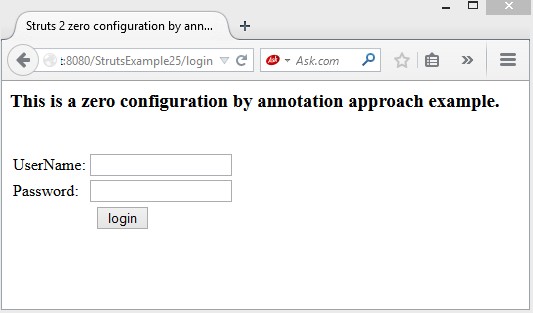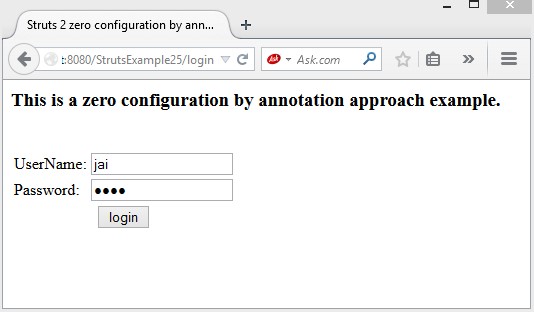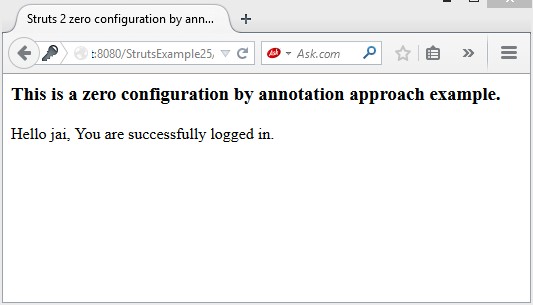As we discussed how to create a struts application using struts.xml file. Struts framework also provides a way to create a struts application without using struts.xml file. Struts framework provides the annotation to achieve this. A struts application without using struts.xml file is also known as application with Zero Configuration.
Some useful annotations.
1. @Action: It is used for action mapping for execute method or marking a class as action class.
2. @Result: It is used to specify the view screen based on the outcome of execute method.
3. @Results: It is used to define multiple results for an action. It is a collection of results.
4. @RequiredFieldValidator: It is used to perform required validation on the field.
Struts 2 Zero Configuration by annotation approach example:
login.jsp
<%@ taglib uri="/struts-tags" prefix="s"%> <html> <head> <title>Struts 2 zero configuration by annotation approach example</title> </head> <body> <h3>This is a zero configuration by annotation approach example.</h3> <s:property value="message" /> <br/> <s:form action="login"> <s:textfield name="userName" label="UserName" /> <s:password name="password" label="Password" /> <s:submit value="login" align="center"/> </s:form> </body> </html> |
web.xml
<?xml version="1.0" encoding="UTF-8"?> <web-app version="2.5" xmlns="http://java.sun.com/xml/ns/javaee" xmlns:xsi="http://www.w3.org/2001/XMLSchema-instance" xsi:schemaLocation="http://java.sun.com/xml/ns/javaee http://java.sun.com/xml/ns/javaee/web-app_2_5.xsd"> <filter> <filter-name>struts2</filter-name> <filter-class> org.apache.struts2.dispatcher.ng. filter.StrutsPrepareAndExecuteFilter </filter-class> </filter> <filter-mapping> <filter-name>struts2</filter-name> <url-pattern>/*</url-pattern> </filter-mapping> <welcome-file-list> <welcome-file>login.jsp</welcome-file> </welcome-file-list> </web-app> |
Login.java
import org.apache.struts2.convention.annotation.Action; import org.apache.struts2.convention.annotation.Result; import com.opensymphony.xwork2.ActionSupport; /** * This class is used as an action class. * @author w3schools */ @Action(value="login", results={ @Result(name="success",location="/welcome.jsp"), @Result(name="error",location="/login.jsp") }) public class Login extends ActionSupport{ //data members private String userName; private String password; private String message; //business logic public String execute(){ if(userName.equals("jai") && password.equals("1234")){ setMessage("Hello " +userName + ", You are successfully logged in."); return SUCCESS; }else{ setMessage("Invalid username or password."); return ERROR; } } //getter setters public String getUserName() { return userName; } public void setUserName(String userName) { this.userName = userName; } public String getPassword() { return password; } public void setPassword(String password) { this.password = password; } public String getMessage() { return message; } public void setMessage(String message) { this.message = message; } } |
login-error.jsp
login-error.jsp
<%@ taglib uri="/struts-tags" prefix="s"%> |
This is a zero configuration by
annotation approach example.
Output:

Enter UserName: jai and Password: 1234

Click on login button.

Next Topic: DispatchAction Functionality in Struts 2 with example.
Previous Topic: Struts 2 Zero Configuration by convention approach with example.